Ceanothus
Ceanothus is a genus of about 50–60 species of nitrogen-fixing shrubs and small trees in the buckthorn family (Rhamnaceae).[2][3][4][5] Common names for members of this genus are buckbrush, California lilac, soap bush, or just ceanothus.[6][7][8] "Ceonothus" comes from a Greek word meaning "spiny plant",[8] Ancient Greek: κεάνωθος (keanōthos), which was applied by Theophrastus (371–287 BC) to an Old World plant believed to be Cirsium arvense.[9][10]
| Ceanothus | |
|---|---|
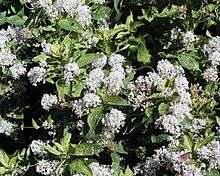 | |
| Ceanothus americanus flowers | |
| Scientific classification | |
| Kingdom: | Plantae |
| Clade: | Tracheophytes |
| Clade: | Angiosperms |
| Clade: | Eudicots |
| Clade: | Rosids |
| Order: | Rosales |
| Family: | Rhamnaceae |
| Genus: | Ceanothus L.[1] |
| Species | |
|
See text | |
The genus is native to North America with the highest diversity on the western coast.[4][11] Some species (e.g., C. americanus) are restricted to the eastern United States and southeast Canada, and others (e.g. C. caeruleus) extend as far south as Guatemala. Most are shrubs 0.5–3 metres (1.6–9.8 ft) tall, but C. arboreus and C. thyrsiflorus, both native to California, can be small multi-trunked trees up to 6–7 metres (20–23 ft) tall.
Taxonomy and etymology
There are two subgenera within this genus: Ceanothus and Cerastes. The former clade is less drought-resistant, having bigger leaves. The evolution of these two clades likely started with a divergence in the niches filled in local communities, rather than a divergence on the basis of geography.[12]
The Californian species of Ceanothus are commonly known collectively as California lilacs, with individual species having more descriptive common names. Species native elsewhere have other common names such as New Jersey tea for C. americanus, as its leaves were used as a black tea substitute during the American Revolution.[2][13] In garden use, most are simply called by their scientific names or an adaptation of the scientific name, such as 'Maritime ceanothus' for C. maritimus.
Description
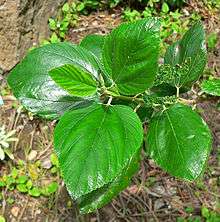
Growth pattern
The majority of the species are evergreen, but the handful of species adapted to cold winters are deciduous. The leaves are opposite or alternate (depending on species), small (typically 1–5 cm long), simple, and mostly with serrated margins.
Leaves and stems
Ceanothus leaves may be arranged opposite to each other on the stem, or alternate. Alternate leaves may have either one or three main veins rising from the base of the leaf.[14]
The leaves have a shiny upper surface that feels "gummy" when pinched between the thumb and forefinger, and the roots of most species have red inner root bark.[15]
Flowers and fruit

The flowers are white, greenish–white, blue, dark purple-blue, pale purple or pink, maturing into a dry, three-lobed seed capsule.
The flowers are tiny and produced in large, dense clusters. A few species are reported to be intensely fragrant almost to the point of being nauseating, and are said to resemble the odor of "boiling honey in an enclosed area". The seeds of this plant can lie dormant for hundreds of years, and Ceanothus species are typically dependent on forest fires to trigger germination of their seeds.[15]
Fruits are hard, nutlike capsules.[8]
Distribution
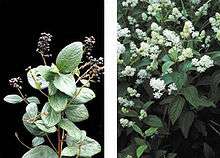
Plants in this genus are widely distributed and can be found on dry, sunny hillsides from coastal scrub lands to open forest clearings, from near sea level to 9,000 feet (2,700 m) in elevation. These plants are profusely distributed throughout the Rocky Mountains from British Columbia south through Colorado, the Cascades of Oregon and California, and the Coastal Ranges of California.
Ceanothus velutinus is the most common member of this genus and is widespread through much of western North America.[15] The plants in this genus often co-occur with one another, especially when they are more distantly related.[12]
Species
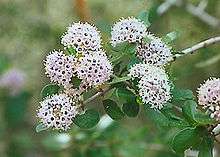
As of September 2019, accepted species are:[4]
- Ceanothus americanus L. – New Jersey tea; red root[16]
- Ceanothus arboreus Greene – feltleaf ceanothus
- Ceanothus arcuatus McMinn
- Ceanothus bolensis S.Boyd & J.E.Keeley
- Ceanothus buxifolius Willd. ex Schult. & Schult.f.
- Ceanothus caeruleus Lag
- Ceanothus confusus J.T. Howell – Rincon Ridge ceanothus
- Ceanothus connivens Greene – trailing buckbrush
- Ceanothus cordulatus Kellogg – whitethorn ceanothus
- Ceanothus crassifolius Torr. – hoaryleaf ceanothus
- Ceanothus cuneatus (Hook.) Nutt. – buckbrush
- Ceanothus cyaneus Eastw. – San Diego buckbrush
- Ceanothus decornutus V.T.Parker
- Ceanothus dentatus Torr. & A.Gray – sandscrub ceanothus
- Ceanothus depressus Benth. – junco
- Ceanothus divergens Parry – Calistoga ceanothus
- Ceanothus diversifolius Kellogg – pinemat
- Ceanothus fendleri A.Gray – Fendler's ceanothus
- Ceanothus ferrisiae McMinn – coyote ceanothus
- Ceanothus foliosus Parry – wavyleaf ceanothus
- Ceanothus fresnensis Dudley ex Abrams – Fresno ceanothus
- Ceanothus gloriosus J.T. Howell – Point Reyes ceanothus
- Ceanothus griseus (Trel. ex B.L.Rob.) McMinn – Carmel ceanothus
- Ceanothus hearstiorum Hoover & J.B.Roof – Hearst Ranch buckbrush
- Ceanothus herbaceus Raf. – Jersey tea
- Ceanothus impressus Trel. – Santa Barbara ceanothus
- Ceanothus incanus Torr. & A.Gray – coast whitethorn
- Ceanothus integerrimus Hook. & Arn. – deerbrush ceanothus
- Ceanothus jepsonii Greene – Jepson ceanothus
- Ceanothus lemmonii Parry – Lemmon's ceanothus
- Ceanothus leucodermis Greene – chaparral whitethorn
- Ceanothus maritimus Hoover – maritime ceanothus
- Ceanothus martinii M.E.Jones – Martin's ceanothus
- Ceanothus masonii McMinn – Mason's ceanothus
- Ceanothus megacarpus Nutt. – bigpod ceanothus
- Ceanothus microphyllus Michx. – littleleaf buckbrush
- Ceanothus ochraceus Suess.
- Ceanothus oliganthus Nutt. – hairy ceanothus
- Ceanothus ophiochilus Boyd, Ross & Arnseth – Vail Lake ceanothus
- Ceanothus otayensis H. E. McMinn – Otay Mountain buckbrush
- Ceanothus palmeri Trel. – Palmer ceanothus
- Ceanothus papillosus Torr. & A.Gray – wartleaf ceanothus
- Ceanothus parryi Trel. – Parry Ceanothus
- Ceanothus parvifolius (S.Watson) Trel. – littleleaf ceanothus
- Ceanothus pendletonensis D.O.Burge, Rebman, & M.R.Mulligan
- Ceanothus perplexans Trel.
- Ceanothus pinetorum Coville – Coville ceanothus
- Ceanothus prostratus Benth. – prostrate ceanothus
- Ceanothus pumilus Greene – dwarf ceanothus
- Ceanothus purpureus Jepson – hollyleaf ceanothus
- Ceanothus roderickii Knight – Pine Hill buckbrush
- Ceanothus sanguineus Pursh – redstem ceanothus
- Ceanothus serpyllifolius Nutt. – Coastal Plain buckbrush
- Ceanothus sonomensis J.T. Howell – Sonoma ceanothus
- Ceanothus spinosus Nutt. – green bark ceanothus
- Ceanothus thyrsiflorus Eschsch. – blueblossom
- Ceanothus tomentosus Parry – woolyleaf ceanothus
- Ceanothus velutinus Dougl. ex Hook. – snowbrush ceanothus
- Ceanothus verrucosus Nutt. – Barranca brush
Uses
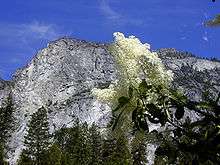
Wildlife
Ceanothus is a good source of nutrition for deer, specifically mule deer along the West Coast of the United States. However, the leaves are not as nutritious from late spring to early fall as they are in early spring. Porcupines and quail have also been seen eating stems and seeds of these shrubs. The leaves are a good source of protein and the stems and leaves have been found to contain a high amount of calcium.
Cultivation
Many Ceanothus species are popular ornamental plants for gardens. Dozens of hybrids and cultivars have been selected, such as flexible ceanothus, Ceanothus × flexilis (C. cuneatus × C. prostratus).
AGM cultivars
The following cultivars and hybrids have gained the Royal Horticultural Society's Award of Garden Merit (as of 2017):[17]
Other cultivars available include:-
There are also more cultivars and hybrids of Ceanothus arboreus, Ceanothus griseus horizontalis (groundcovers), and Ceanothus thyrsiflorus in the nursery trade.
Propagation
Propagation of ceanothus is by seed, following scarification and stratification. Seeds are soaked in water for 12 hours followed by chilling at 1 °C for one to three months. It can also sprout from roots and/or stems. Seeds are stored in plant litter in large quantities. It is estimated that there are about two million seeds per acre in forest habitats. Seeds are dispersed propulsively from capsules and, it has been estimated, can remain viable for hundreds of years. In habitat, the seeds of plants in this genus germinate only in response to range fires and forest fires.
Other uses
Native Americans used the dried leaves of this plant as an herbal tea, and early pioneers used the plant as a substitute for black tea. Miwok Indians of California made baskets from Ceanothus branches. Ceanothus integerrimus has been used by North American tribes to ease childbirth.[36]
References
- "Genus: Ceanothus L." Germplasm Resources Information Network. United States Department of Agriculture. 2004-02-10. Archived from the original on 2009-01-14. Retrieved 2012-04-25.
- Chisholm, Hugh, ed. (1911). . Encyclopædia Britannica (11th ed.). Cambridge University Press.
- http://web.uconn.edu/mcbstaff/benson/Frankia/Rhamnaceae.htm
- "Ceanothus L." Plants of the World Online. Royal Botanical Gardens Kew. Retrieved 29 September 2019.
- Calflora Database: Index of Ceanothus species native to California
- "Ceanothus". Natural Resources Conservation Service PLANTS Database. USDA. Retrieved 29 September 2019.
- McMahan, L. R. WaterWise Plant Profiles. Oregon State University Extension Service.
- Flowering Plants of the Santa Monica Mountains, Nancy Dale, 2nd Ed., 2000, pp. 166–167
- Elmore, Francis H. (1976). Trees and Shrubs of the Southwest Uplands. Western National Parks Association. p. 195. ISBN 0-911408-41-X.
- Austin, Daniel F. (2004). Florida Ethnobotany. CRC Press. p. 291. ISBN 978-0-8493-2332-4.
- "Largest Genera in Continental North America". BONAP. Retrieved 29 September 2019.
- Ackerly, D. D.; Schwilk, D. W.; Webb, C. O. (2006). "Niche evolution and adaptive radiation: Testing the order of trait divergence". Ecology. 87 (sp7): S50–S61. doi:10.1890/0012-9658(2006)87[50:NEAART]2.0.CO;2. ISSN 0012-9658.
- Coladonato, Milo (1993). "Ceanothus americanus". Fire Effects Information System (online). Rocky Mountain Research Station, Fire Sciences Laboratory (Producer): U.S.D.A; Forest Service. Retrieved March 3, 2016.
- Native Shrubs of the Sierra Nevada, John Hunter Thomas, Dennis R. Parnell, University of California Press, 1974, p. 70–77,
- Edible and Medicinal Plants of the West, Gregory L. Tilford, ISBN 0-87842-359-1
- University of Wisconsin–Stevens Point Plant Database: Ceanothus americanus Archived 2007-01-16 at the Wayback Machine
- "AGM Plants - Ornamental" (PDF). Royal Horticultural Society. July 2017. p. 16. Retrieved 24 January 2018.
- "RHS Plantfinder - Ceanothus 'Autumnal Blue'". Royal Horticultural Society. Retrieved 21 January 2018.
- "RHS Plant Selector - Ceanothus 'Blue Mound'". Retrieved 15 April 2020.
- "RHS Plant Selector - Ceanothus 'Burkwoodii'". Retrieved 15 April 2020.
- "RHS Plant Selector - Ceanothus 'Cascade'". Retrieved 15 April 2020.
- "Ceanothus 'Concha'". RHS. Retrieved 12 April 2020.
- "Ceanothus 'Dark Star'". RHS. Retrieved 12 April 2020.
- "Ceanothus × delileanus 'Gloire de Versailles'". RHS. Retrieved 12 April 2020.
- "Ceanothus thyrsifolius 'Mystery Blue'". RHS. Retrieved 12 April 2020.
- "Ceanothus × pallidus 'Perle Rose'". RHS. Retrieved 12 April 2020.
- "Ceanothus 'Puget Blue'". RHS. Retrieved 12 April 2020.
- "Ceanothus 'Skylark'". RHS. Retrieved 12 April 2020.
- "Ceanothus × delineanus 'Topaze'". RHS. Retrieved 12 April 2020.
- "Ceanothus arboreus 'Trewithen Blue'". RHS. Retrieved 12 April 2020.
- "Ceanothus thyrsifolius var. repens". RHS. Retrieved 12 April 2020.
- Marcos Growers Horticulture Database: Ceanothus 'Anchor Bay'
- San Marcos Growers Horticulture Database: Ceanothus griseus horizontalis 'Diamond Heights'
- Marcos Growers Horticulture Database: Ceanothus 'Ray Hartman'
- San Marcos Growers Horticulture Database: Ceanothus thyrsiflorus 'Snow Flurry'
- Moerman, D. (1988). Native American Ethnobotany. Timber Press, Oregon.